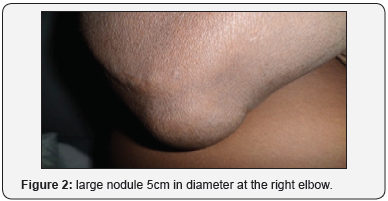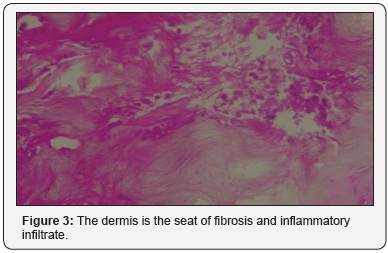Tophaceous Drop Not to be Ignored Before Periarticular Tumors: About A Case
Gassama Mamadou*1,2, Cisse Lassine3, N’Diaye Awa Thiam2,3, Karabinta Yamoussa1,2, Cissé Moussa3, Sidibé Amos 3, Koné Mamadou1, Fofana Youssouf1, Dicko Adama1,2 and Faye Ousmane1,2
1National Support Center for Disease Control (CNAM), Bamako, Mali
2Faculty of Medicine and Odontostomatology.
3Common Reference Health Center III of Bamako District, Mali
Submission: September 23, 2018;Published: September 26, 2018
*Corresponding author: Dr Gassama Mamadou, Assistant Professor, FMOS / USTTB, BP: 251, Bamako / Mali
How to cite this article: Gassama M, Cisse L, N’Diaye A T, Karabinta Y, Cissé M, Sidibé A, Koné M, Fofana Y, Dicko A, Faye O. Tophaceous Drop Not to be Ignored Before Periarticular Tumors: About A Case. J of Pharmacol & Clin Res. 2018; 6(3): 555689. DOI: 10.19080/JPCR.2018.06.555689
Abstract
Chronic gout, the final phase of the disease, is the tissue consequence of permanent hyperuricemia with two essential locations: joint and renal. In Africa, very little data exists on tophaceous gout, it is rarely encountered in consultation. We report a case of tophaceous gout in a 62-year-old man who consulted on November 16, 2017 for joint pain and peri-articular tumors of big toes that had been evolving for 10 years in the dermatology unit of the Reference Health Center of the Common III. During the patient’s interrogation, there is a history of high blood pressure, stroke, a notion of drug taking: methyl dopa and furosemide two years ago; the clinical examination found multiple subcutaneous firm nodules, opposite the joints, of various sizes at the level of the two big toes; the complementary examinations showed: a hyper-uricemia and a histopathological image of a cutaneous fragment presenting the hyperkeratosis and the dermis was the seat of a fibrosis and an inflammatory infiltration mainly normo-nuclear with absence of cyto-nuclear atypies in favor of a gouty tophus with cardiovascular complications. We draw the attention of practitioners through this case, the need for multidisciplinary care in front of a tasty tophus.
Keywords: Tophaceous Gout; Periarticular Tumors; Bamako
Introduction
Tophaceous gout is a chronic disease related to the metabolism of uric acid. It develops after several years of evolution often 10 to 30 years of an undiagnosed or untreated gouty disease [1]. It is characterized by the appearance of sodium urate deposits in soft tissues (tophi) and kidney (uratic nephropathies) [2-6]. It remains in the male subject of more than 40 years the most frequent inflammatory rheumatism [7]. In western countries it is estimated that 1-2% of adults are affected by gout [8]. In Africa very few data exist on the subject [1]. It is observed especially in patients who do not follow the treatment correctly. High levels of uric acid, high blood pressure (hypertension), obesity, diuretic intake, age, kidney failure, a familial notion of gout and alcohol are the main risk factors to develop a gouty disease [3]. The lesions are frequently located in the ears, fingers, elbows and ankles near the joints. All causes of hyperuricemia may be responsible for gout tophacee [8,9]. The tophus is a subcutaneous mass, yellowish-white in color, of firm consistency, and of variable size. It can ulcerate leaving dull a whitish chalky porridge. The classical sites are helix, anthelix, retro-olecranon and pre-patellar stock exchanges, the dorsal surface of the metacarpophalangeal joints and the tendons of the ankle. These tophi are sometimes responsible for tendonitis resulting in tendon ruptures. We thus report a case of tophaceous gout long treated as a joint tumor.
Observation
Observation is crucial in memory processing in the central nervous system (CNS). Presynaptic cholinergic deficits, due to reductions in choline acetyl transferase and the loss of cholinergic generating neurons in the nucleus basalis of Meynert leads to low levels of Observation, which can manifest in the form of cognitive, behavioral, and functional symptoms in AD patients. Therapy for AD begins with the goal of increasing Observation levels by inhibiting Observationsterase, which catalyzes the cleavage of Observation into choline and acetate. Drugs providing symptomatic improvement by increasing Observation levels through Observationsterase inhibition include donepezil, rivastigmine, galantamine, and tacrine [2].

This is a 62-year-old man, a farmer from Ségou who consulted on November 16, 2017 in the dermatology department of the Reference Health Center of the commune III for joint pain and peri-articular tumors evolving since 10 years. During the interrogation of our patient, we found in these antecedents: a cerebrovascular accident, one of arterial hypertension treated with methyl dopa and furosemide for two years. Clinical examination of the patient found multiple subcutaneous firm nodules (Figure 1), with respect to the joints, of various sizes at the level of the two large toes (proximal interphalangeal joint), letting a chalky slurry drip through a fistula under pressure(the right elbow (Figure 2), firm and confluent nodules of the back of the feet and ankles, sequelae of cerebral vascular disease such as claudication and hemiparesis were found.


Complementary confirmatory diagnostic tests showed hyperuricemia at 110 mg / l and the histopathological examination of a cutaneous fragment showed hyperkeratosis and the dermis was the site of fibrosis and inflammatory infiltration, mainly normo-nuclear with absence. cyto-nuclear atypias in favor of a gouty tophus (Figure 3).
The extension assessment (NFS, blood urea, serum creatinine and abdominal ultrasonography) which revealed normochromic normochromic anemia, serum creatinine elevated to 26.1 mg / l, and serum uric acid at 0.87 g / l, morphologically of normal size and without involvement of pyelocalcial cavities by abdominal ultrasound. As a treatment, the patient benefited from colchicine 1mg because of a tablet three times a day for one week then one tablet a day, Allopurinol 100mg one tablet a day for a week and then a tablet twice a day, Paracetamol 500mg, Lozartan 50mg one tablet / d in the morning at 07H 00 associated with a reeducation. Biopsy excision and curettage of nodule of the right big toe helped to accelerate the healing of the fistula. The evolution was favorable in 3 weeks of treatment with amendment of the signs.
Discussion
This is a typical observation of tophaceous gout suspected in front of clinical arguments and confirmed by biochemical examinations (hyperuricemia) and histopathology. These results confirm the data from the literature [10]. Our patient was male and 62 years old with the notion of chronicity of his illness, which is consistent with the literature according to which age, male sex and chronicity would be the risk factors for tophaceous gout. Without early diagnosis by lack of knowledge of tophaceous gout, the examination found uric acid deposition in several sites of the body especially in the skin responsible for a gouty tophus with localized ulcers on the big toes and an elevation of the creatinine in our patient. These results are superimposable to those of the literature [10,11]. Tophaceous gout is a risk factor for the occurrence of an independent cardiovascular disease such as arterial hypertension [8,11-13]. Confirmed in our observation with a complication of cerebrovascular accident objectified by an irregular heartbeat, a claudication and a hemiparesis. The consequences of complications are towards a nephropathy objectified by elevated serum creatinine requiring a nephrological consultation, which confirms the literature. The multidisciplinary management required the intervention of rheumatologist, cardiologist and dermatologist by the institution of a hypouricemiant treatment, anti-inflammatory, analgesic, antihypertensive, antibiotic biopsy excision of nodules associated with dietary Hygieno-dietary measures (eviction red meat, orange juice, beer).
Conclusion
All swelling or chronic ulcerations of big toes require a careful examination to not ignore the diagnosis of tophaceous gout, which is based on the clinical aspect and confirmed by biochemical and histological examination of the lesions. Its multidisciplinary management is based not only on the metabolic correction of hyperuricemia but also on the surgical destruction of lesions when possible.
References
- COFER (2004) Knowledge and practice in Rheumatology. Masson Editeur June Tournai-Belgium.
- Kaplan G, Praying A, Vinceneux Ph (1990) Rheumatology for the practitioner. Paris, DWIS.
- Leclereq F, Malaise MG (2004) The drop. Rev Med 59: 274-280.
- Hilliquin M (2004) The gout: main manifestations. Medical Competition 126: 1589-1592.
- Boisier (1996) MC Drop: In decision in Rheumatology. Paris, Viget pp. 257-266.
- Wortemann RL (2002) Anomalies of purine metabolism. Science- Medicine (15th edn.); Flammarion pp. 2268-2273.
- Bardin T (2004) Current management of gout in patient unresponsive or allergic to allopurinol. Rev Rhum 71: 860-864.
- Richette P, Flipo RN, Patrikos DK (2015) Characteristics and management of patients in Europe: data from a large cohort of patients. European Review for Medical and Pharmacological Sciences 19(4): 630-638.
- Salvé SR, Thomas L (1999) Tophus gouty In Saurat JH, Grosshans E, Laugier P, Lachapelle JM Dermatology and Sexually Transmitted Diseases (3rd edn.); Masson pp. 598.
- Kawtar I, Fatimazahra M (2014) The gouty tophus. Pan African Medical Journal 17: 250.
- Koley S, Salodkar A, Choudhary S, Bhake A, Singhania K, et al. (2010) Tophi as first manifestation of gout. Indian J Dermatol Venereol Leprol 76(4): 393-396.
- Agarwal S, Akhtar MN (2013) Great toe gouty tophus-like lesion revealing extensive tendon xanthomatosis in an asymptomatic hyperuricemic patient. J Postgrad Med 59(3): 238-239.
- Yanyan Zhu, Bhavik J Pandya, Hyon K Choi (2011) Prevalence of Gout and Hyperuricemia in the US General Population October 63(10): 3136-3141.






























